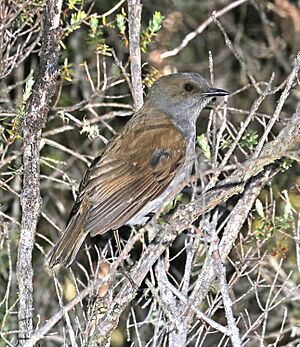ʻŌmaʻo facts for kids
Quick facts for kids ʻŌmaʻo |
|
|---|---|
 |
|
| Conservation status | |
| Scientific classification | |
| Genus: |
Myadestes
|
| Species: |
obscurus
|
The ʻōmaʻo (Myadestes obscurus), also called the Hawaiian thrush, is a special bird. It's like a robin and lives only on the Big Island of Hawaii. The ʻōmaʻo is related to other unique thrushes found only in the Hawaiian Islands, such as the kāmaʻo and puaiohi.
You can mostly find ʻōmaʻo birds in the rainforests on the east and southeast sides of the Big Island. There are about 170,000 of them. This makes them the most common Hawaiian thrush. Even though their numbers are steady, they are considered "vulnerable." This is because they live only on one island in a small area.
Contents
About the ʻŌmaʻo's Name
The ʻōmaʻo was officially named in 1789. A German scientist named Johann Friedrich Gmelin gave it the scientific name Muscicapa obscura. The word obscura comes from Latin and means "dark" or "dusky."
Gmelin learned about the bird from an English bird expert named John Latham. Latham had seen a specimen, which is a preserved example of an animal. This specimen came from the "Sandwich Islands," which we now call the Hawaiian Islands. Today, the ʻōmaʻo is placed in a different group of birds called Myadestes.
What the ʻŌmaʻo Looks Like
Adult ʻōmaʻo birds, both males and females, look very similar. Their heads are a grayish-brown color. This color fades to a pale gray underneath their bodies.
Their backs and main wing feathers are a dull olive-brown. They also have whitish feathers under their tails. Young ʻōmaʻo birds are also dull in color. However, they have light, whitish-buff spots on their wing feathers.
ʻŌmaʻo Behavior and Life Cycle
ʻŌmaʻo birds mostly eat fruit. But they also like to snack on insects and other small creatures without backbones.
These birds have a unique song. It sounds like jerky, liquid notes, like "whip-per-weeo-whip-per-weet." They also make many different calls. Some sound like a cat's scratchy meow, others like a frog's croak. They can even make a high-pitched sound like a police whistle!
During breeding season, ʻōmaʻo birds build a large nest. They usually place it in a tree or a tree fern. Inside the nest, the female lays one to three bluish eggs.
Where the ʻŌmaʻo Lives
The ʻōmaʻo used to live across most of the Big Island of Hawaii. Today, they are found only on the southern and eastern parts of the island. They mostly live above 1,000 meters (about 3,300 feet) in elevation. This is only about 25 to 30 percent of the area they once called home.
Their favorite place to live is in rainforests. But you can also find them in high shrublands on Mauna Loa volcano. They especially like areas with ohia and koa trees. The Hawaiian thrush avoids places where an invasive vine called banana poka grows.
At lower elevations, some ʻōmaʻo birds seem to be naturally resisting avian malaria. This is a disease that can harm birds.
Threats and Conservation
The ʻōmaʻo faces several dangers. These include:
- Habitat destruction: Their homes are being lost due to new houses and farms.
- Introduced animals: Wild animals like rats, cats, and mongooses hunt these birds.
- Invasive plants: Plants that don't belong in Hawaii can take over their habitat.
- Wild livestock: Animals like pigs can damage their environment.
Luckily, people are working to help the ʻōmaʻo. For example, in the 1990s, pigs were removed from areas like the Hakalau Forest National Wildlife Refuge. These efforts help protect the ʻōmaʻo and its home.



